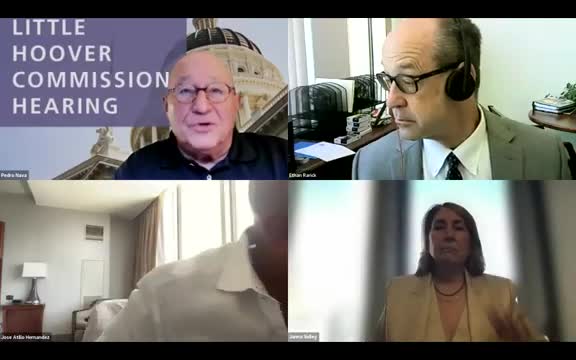Little Hoover Commission Begins Hearing on Electricity Costs with Chair Pedro Nava
July 26, 2025 | Little Hoover Commission, Other State Agencies, Executive, California
This article was created by AI summarizing key points discussed. AI makes mistakes, so for full details and context, please refer to the video of the full meeting. Please report any errors so we can fix them. Report an error »

The Little Hoover Commission convened on July 24, 2025, for the fourth part of its hearing on electricity costs in California, highlighting ongoing concerns about energy pricing and its implications for residents and businesses. Chaired by Pedro Nava, the meeting brought together various commissioners and staff members, including notable figures such as Senator Roger Nilo.
The session began with procedural announcements, including the availability of public comments via Zoom, emphasizing the commission's commitment to transparency and community engagement. Participants were encouraged to share their views, reflecting the commission's aim to incorporate public input into its discussions.
As the hearing progressed, the focus shifted to the critical issue of electricity costs, which have been a growing concern for Californians. The commission's discussions are particularly relevant given the state's ambitious energy goals and the need for sustainable solutions that balance affordability with environmental responsibility.
The implications of rising electricity costs were underscored, as they affect not only household budgets but also the operational expenses of businesses across the state. The commission's inquiry into these costs aims to identify potential reforms and strategies that could alleviate financial burdens on consumers while ensuring a reliable energy supply.
In addition to the primary topic of electricity pricing, the meeting also touched on related issues such as energy efficiency programs and the integration of renewable energy sources. These discussions are crucial as California seeks to transition to a greener energy landscape while managing the economic impacts on its residents.
In conclusion, the Little Hoover Commission's hearing on electricity costs serves as a vital platform for addressing the challenges faced by Californians in the energy sector. As the commission continues its work, the outcomes of these discussions may lead to significant policy recommendations aimed at improving the affordability and sustainability of electricity in the state. The next steps will involve synthesizing the insights gathered from public comments and expert testimonies to inform future actions.
The session began with procedural announcements, including the availability of public comments via Zoom, emphasizing the commission's commitment to transparency and community engagement. Participants were encouraged to share their views, reflecting the commission's aim to incorporate public input into its discussions.
As the hearing progressed, the focus shifted to the critical issue of electricity costs, which have been a growing concern for Californians. The commission's discussions are particularly relevant given the state's ambitious energy goals and the need for sustainable solutions that balance affordability with environmental responsibility.
The implications of rising electricity costs were underscored, as they affect not only household budgets but also the operational expenses of businesses across the state. The commission's inquiry into these costs aims to identify potential reforms and strategies that could alleviate financial burdens on consumers while ensuring a reliable energy supply.
In addition to the primary topic of electricity pricing, the meeting also touched on related issues such as energy efficiency programs and the integration of renewable energy sources. These discussions are crucial as California seeks to transition to a greener energy landscape while managing the economic impacts on its residents.
In conclusion, the Little Hoover Commission's hearing on electricity costs serves as a vital platform for addressing the challenges faced by Californians in the energy sector. As the commission continues its work, the outcomes of these discussions may lead to significant policy recommendations aimed at improving the affordability and sustainability of electricity in the state. The next steps will involve synthesizing the insights gathered from public comments and expert testimonies to inform future actions.
View full meeting
This article is based on a recent meeting—watch the full video and explore the complete transcript for deeper insights into the discussion.
View full meeting
